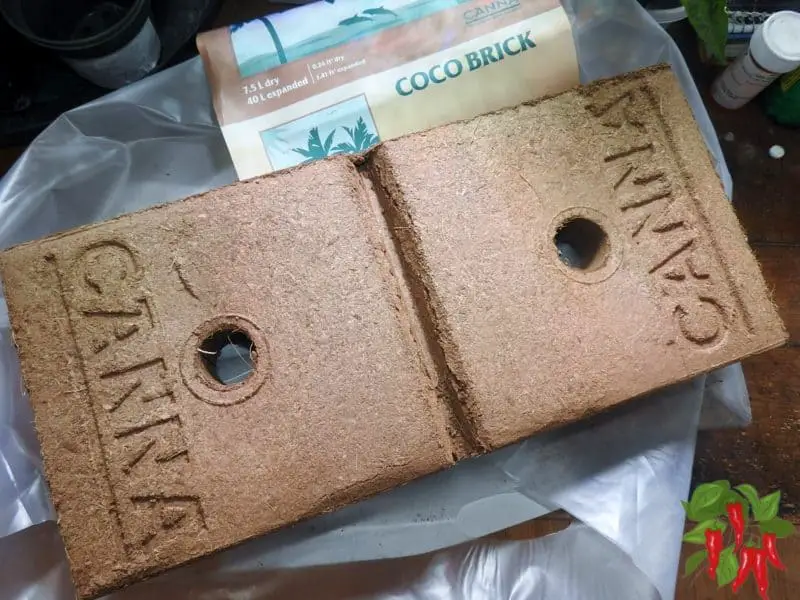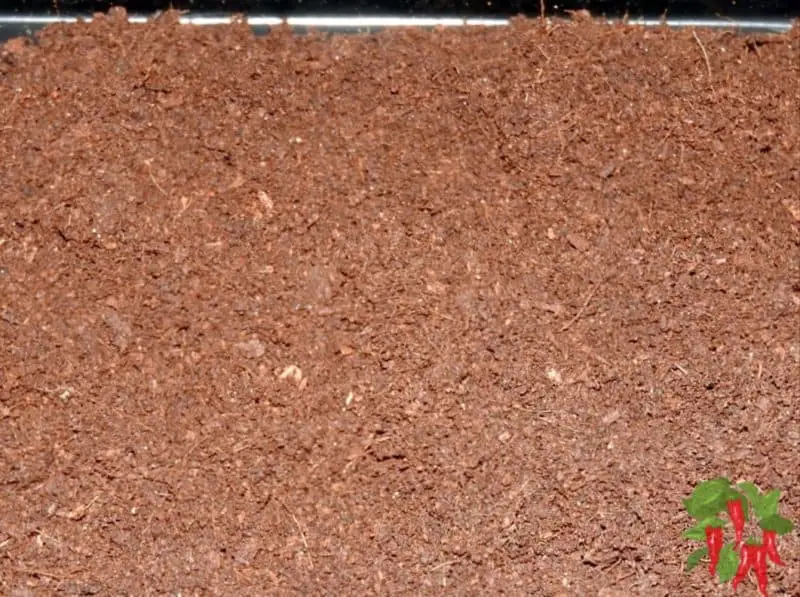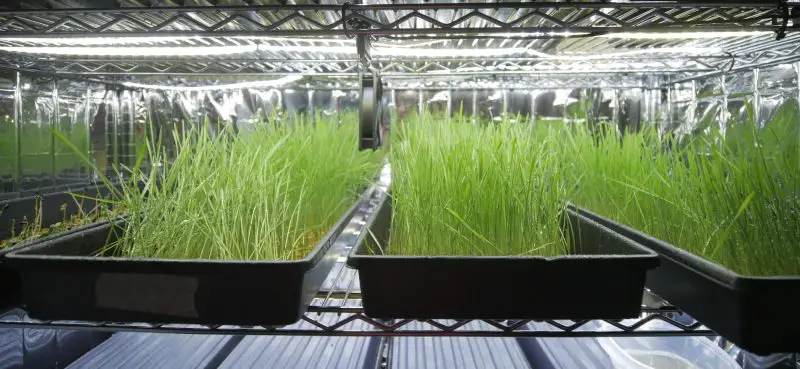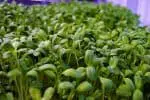This post contains affiliate links. If you buy something from one of our links we may earn a commission. Thanks

If you are looking for a growing medium that is sustainable and environmentally friendly, look no further than coconut coir.
Coco Coir Key Takeaways:
- Using Coconut Coir for Microgreens is a sustainable choice as it’s made from renewable resources.
- It provides an excellent water-holding capacity and a conducive environment for root growth.
- It’s a natural, biodegradable medium that promotes healthy germination and growth of microgreens.
- It is an eco-friendly alternative to peat moss or traditional soil.
Coconut coir is made from the fibrous husks of coconuts. This unique growing medium has many benefits for microgreens growers.
In this blog post, we will discuss the benefits of using coconut coir for microgreens growth, and provide tips on how to grow microgreens with it effectively.
What is coconut coir?
Coconut coir is a natural fiber made from the husks of coconuts. When coconut shells are processed they yield coco peat, coco fiber, and coco chips.
Coco pith or coco peat is very fine and looks a lot like peat moss. Coco fiber is used to make mats and baskets and coco chips are often used to aerate the soil.
Coco coir is actually a mix of all three of these products and the only thing you need to grow microgreens although you can also use coco mats as a planting base for small seeds.

It is resistant to many soil-borne diseases, making it an ideal material for use in gardening.
Coconut coir can also be used as an environmentally friendly alternative to peat moss.
Unlike peat moss, which takes centuries to develop, coconut coir is a renewable resource that can be harvested without damaging the environment.
In addition, coconut coir is more absorbent than peat moss, making it an excellent choice for use in potting mixes and garden beds.
Whether you are looking for an eco-friendly alternative to peat moss or simply want a better way to improve drainage in your garden, coconut coir is worth considering.
Using Coco Coir Mats For Microgreens
I am using coco coir mats to grow microgreens. If you want to sell microgreens for profit you can sell your microgreens in the mat itself.
Once a plant is cut it starts to deteriorate and lose nutrition. Selling the microgreens in the mat allows the buyer to have fresh microgreens they can harvest themselves.
Even if you are not going to grow microgreens for profit this is a great way to grow your own microgreens.
Coco Coir Benefits For Microgreens
Coconut coir is an excellent growing medium for microgreens due to its high water retention capabilities.
Coconut coir can hold up to eight times its weight in water, making it ideal for growing microgreens.
This property of coconut coir helps to reduce the frequency of watering, as the roots of the plants will have access to a consistent supply of moisture.
Coconut coir is also a very stable growing medium, meaning that it will not compact or break down over time like other organic materials such as peat moss.
Another benefit of using coconut coir for microgreens is that it is naturally free from harmful bacteria and fungi.
Coconut coir is also a very eco-friendly growing medium, as it is made from a renewable resource. I think coco coir is the best medium for microgreens.
Hydrating Coco Coir
When using coconut coir for microgreens, it is important to make sure that the coir is properly hydrated before adding your seedlings.
Coconut coir matting should be placed in a tray and allowed to soak for a few hours before draining off the water and sowing seeds.
Coconut coir bricks can be hydrated by soaking them in water for several hours. Once the coir has been fully hydrated, any excess water should be drained off and then your coco coir is ready to use.
Planting In Coco Coir
To plant your microgreens in coconut coir, simply press the seeds into the soil and lightly water them.
Growing And Harvesting
Place the container of planted microgreens in a warm, sunny location and keep the soil moist. Your microgreens should germinate within 7-10 days.
When harvesting your microgreens, cut them at the soil line with a sharp knife or pair of scissors.
Coconut coir can be reused for several growing cycles before it needs to be replaced.
If you are looking for a sustainable and environmentally friendly growing medium for your microgreens, look no further than coconut coir. Coconut coir is an excellent choice for those looking to reduce their impact on the environment while still enjoying fresh, healthy microgreens.
Coco Coir Vs Peat
Any gardener will tell you that healthy plants need healthy soil. Not only does soil provide essential nutrients, but it also helps to regulate moisture and aeration levels.
As a result, choosing the right type of soil is essential for successful gardening. For many years, peat moss was the go-to soil amendment for gardeners.
However, recent concerns about the sustainability of peat moss have led many gardeners to seek out alternatives.
Coco coir is a popular option. This product is made from coconut husks, making them a sustainable choice.
In addition to being excellent at retaining moisture and aerating the soil it is also pH neutral while sphagnum peat is very acidic and needs the addition of lime before use.
What are the benefits of using coconut coir?
Coconut coir is a sustainable and environmentally friendly growing medium. Coconut coir is made from the husks of coconuts, which are a renewable resource.
Coconut coir is also biodegradable, making it an excellent choice for those looking to reduce its impact on the environment.
Coconut coir is also an excellent growing medium for microgreens. Coconut coir is lightweight and holds water well, making it easy to transport and store.
Coconut coir is also reusable, meaning you can use it for multiple growing cycles before needing to replace it.
Coco Coir Vs Soil Microgreens
You can grow great microgreens in coco or soil but coco coir is the better choice in terms of moisture retention and it is much more environmentally friendly than peat soil mixes.
Coco coir is naturally pH neutral. Peat is strongly acidic so lime must be added to make it usable. Peat is hard to wet so wetting agents are added too.
Peat-based soil mixes become unusable once the lime and wetting agents are used up. Coco coir on the other hand can be used 2 or 3 times before it loses its texture.
There really is not a reusable growing medium for microgreens. Although you should not reuse coco coir for microgreens you can reuse it to pot up other plants.
I prefer coconut coir for microgreens. I am really against using peat-based products as you probably can tell. They are not reusable either.
What Are The Disadvantages Of Using Coconut Coir?
Coconut coir can be difficult to find in stores, making it more expensive than other growing mediums.
Another disadvantage of coco is that fungus gnats love it but this can be largely avoided by using coco bricks. You should know peat or soil can also attract them too.
Coco coir is available loose in bags or in bricks of compressed coco coir. Especially if ordering online coco bricks is the way to go.
How To Use Coco Bricks For Microgreens And Why
 I use Canna Coco bricks. They are the best choice if you have to order coco online. They are easier to ship and for you, they are much easier to store.
I use Canna Coco bricks. They are the best choice if you have to order coco online. They are easier to ship and for you, they are much easier to store.
Each package has 2 bricks and each brick makes about 5 gallons of coco coir. The bricks can each be broken in half again.
They come wrapped in a plastic bag that can be used to rehydrate them although I prefer using a plastic storage tote,
The nice thing is you are not dealing with a larger brick and although coco bricks are not hard to rehydrate bigger bricks need more time and more water to do the job.
I have found that the bricks are too dry for fungus gnat larvae to survive. I had little trouble with them once I switched from bagged coco to bricks.
Precharge Your Coco Coir
Unlike soil, coco coir does not supply nutrients to plants. So it needs to be primed to get it ready for plants.
If you are using coco to grow microgreens you can skip this step. Microgreens generally don’t need any fertilizer.
They grow so fast that the seed itself can provide them with all they need to grow.
But you will get a better crop of microgreens if you prime your coco so I recommend doing this.
How To Prime Your Coco
 Coco coir is naturally low in calcium, magnesium, and iron. So you will want to add some calmag to the water you soak your bricks in.
Coco coir is naturally low in calcium, magnesium, and iron. So you will want to add some calmag to the water you soak your bricks in.
Again there are lots of brands out there. I have tried most of them and CaliMagic stands heads and shoulders above the rest.
I use 2-3 gallons of water to rehydrate a single brick. I add about 3 ml per gallon which works out to about 300 ppms which is totally safe for germinating seedlings.
You can speed up the hydration process a bit by breaking the brick apart with your hands as it softens. It usually takes less than an hour to totally rehydrate a coco brick.
Then fluff it up a bit. Drain off any leftover water if there is any and your coco is ready for growing microgreens or anything else.
Who Makes The Best Coco Coir
There are many brands of coco coir available today. Some are good and some are bad. Beware of cheap coco coir because it may not be a bargain at all.
Coconut palms are very salt-tolerant plants. You often will see them growing on the shoreline. They can absorb a lot of salt as sodium and potassium.
This must be leeched out of the coconut shells before it can be used for growing plants.
A lot of coco is sold as animal bedding and although it is much cheaper its high salt levels make it unsuitable for agricultural use.
I use Canna Coco. I have used it for many years and it is always high quality. It is probably the industry leader for coco coir and was probably the first to market it.
It is salt-free and has a great texture. It may cost a bit more but the quality is worth the price.
How Do I Use Coconut Coir For Microgreens?
To use coconut coir for microgreens, simply soak the coir bricks in water to expand them.
Drain off any excess water and it’s ready to use. If you have loose coco in bags it is ready to use right out of the bag.
Coconut coir can be used on its own or mixed with other growing mediums such as vermiculite or perlite or even soil.
But if you are using coco to grow microgreens you should not mix it with anything else. It is perfect for growing microgreens just as it is.
Once your coconut coir is ready to use, you will need to plant your microgreens. Coco coir works great for sprouting seeds, as it holds moisture well and provides good drainage.
It also promotes extensive root growth. I can’t say why but roots love growing in coco coir.
You can get twice the root mass in coco coir compared to sphagnum peat or soil. And the roots will be a beautiful white and very healthy.
Use Planting Trays To Grow Your Microgreens
Microgreens are grown in plastic trays. You can use recycled plastic food containers if you wish.
Make sure you sterilize them first with a mix of 10 parts water to 1 part bleach.
 I prefer to use 1020 trays. These are the common seedling trays you see at the garden center.
I prefer to use 1020 trays. These are the common seedling trays you see at the garden center.
They are available with and without holes in the bottom.
You want to place the tray with drainage holes inside one without holes if you are worried about overwatering.
I only use regular trays. You may want to double them up if you will be moving them around.

To plant your microgreens, simply place your seeds on top of the coconut coir and lightly press them into the media.
Once your seeds are planted, you will need to water them. Coconut coir has a high water-holding capacity, so you will need to be careful not to overwater your microgreens.
If you are using coco bricks your tray probably won’t need any water at all. For moist loose coco, I would just mist the top surface rather than watering deep.
Once your microgreens have sprouted, they may need to be watered daily. Again be careful because coco coir can hold a lot of water.
It can often look dry on the surface but still be holding lots of moisture. If you aren’t sure stick your finger in below the surface,
Once your microgreens have grown to the desired height, usually about 3 inches they are ready to harvest.
Can You Reuse Coconut Coir For Microgreens?
Coconut coir can be reused for multiple growing cycles, so you might want to save some for your next batch of microgreens.
I really don’t think trying to reuse this coco for microgreens is a good idea because it will be full of roots and stubble.
But you can either compost it or break it up and use it in larger pots for growing vegetables or houseplants.
How To Reuse Coco For Microgreens
If you really want to use it to grow microgreens again then break it up and try to remove as many roots as you can.
Then sterilize it. You can put it in a turkey roasting pan and pop it into a 350° oven for a half hour.
Advantages Of Using Coco Coir For Microgreens
• Coconut coir is a sustainable, natural growing medium that can be used over and over again.
• Coconut coir is perfect for microgreens because it holds just the right amount of moisture, drains well, and provides good aeration.
• Coconut coir can be reused several times before it needs to be replaced.
Coconut Coir FAQs
Navigating the garden of microgreen cultivation can bring up a bouquet of questions.
This FAQ section is cultivated to address common queries and guide you through the nurturing process of your tiny greens.
From the choice of growing medium to the nurturing environment, these answers are seeded with insights to help you grow a lush microgreen garden.
Q. What makes coconut coir a preferable medium for microgreens?
A. Coconut coir is a natural, renewable medium, excellent for water retention and aeration.
Its fibrous nature creates a conducive environment for root growth, making it preferable for microgreens which thrive on moisture and good drainage.
Q. How do I prepare coconut coir for microgreen cultivation?
A. To prepare coconut coir, soak the coir bricks in water for a few hours until they expand. Drain excess water, and it’s ready to use.
Loose coco coir is also sold in bags and is ready to use as is.
If using coco coir mats, place them in a tray, soak them for a few hours, drain the water, and sow your seeds.
Q. Can coconut coir be reused for growing microgreens?
A. While coconut coir can be reused, it may not be ideal for microgreens due to the presence of previous roots and stubble.
However, it can be composted or used in larger pots for other plants, contributing to its sustainability.
Q. How does coconut coir compare to peat moss for growing microgreens?
A. Unlike peat moss, which is acidic and non-renewable, coconut coir is pH neutral and sustainable.
It also retains moisture better than peat moss, making it a more environmentally friendly and effective choice for growing microgreens.
Coconut Coir for Microgreens Final Thoughts
Coconut coir is an excellent growing medium for microgreens. Coconut coir is sustainable and environmentally friendly, and it is also a great choice for those looking to reduce their impact on the environment.
Coconut coir is also an excellent growing medium for microgreens because it is lightweight, holds water well, and is reusable.
If you are looking for an easy way to get started with growing microgreens, coco coir is a great choice.




